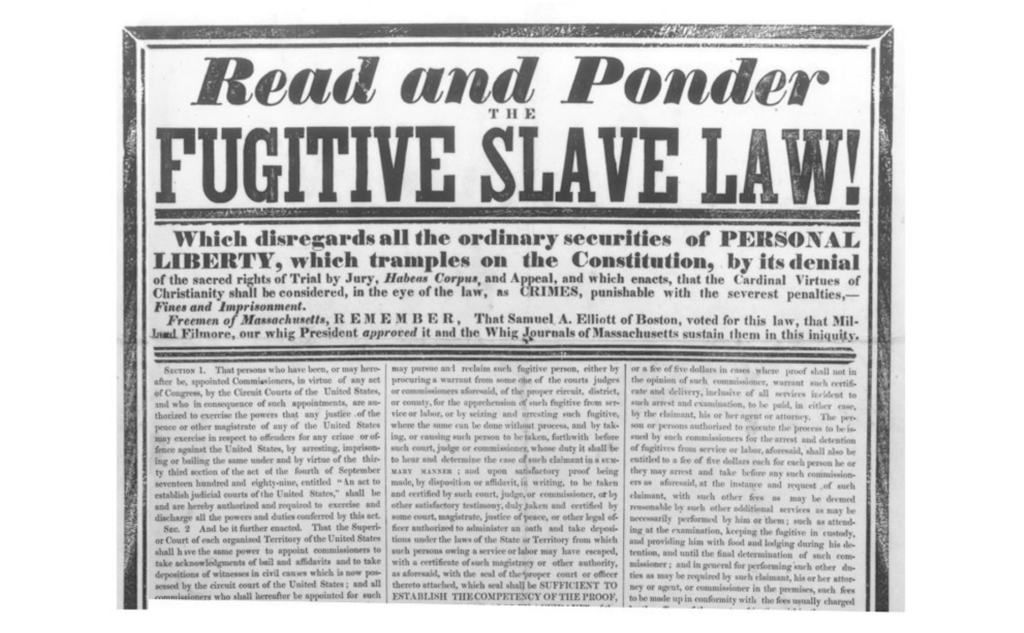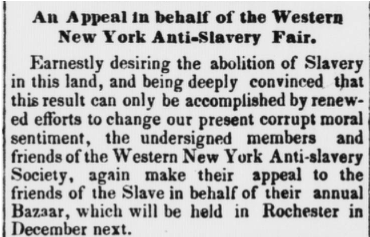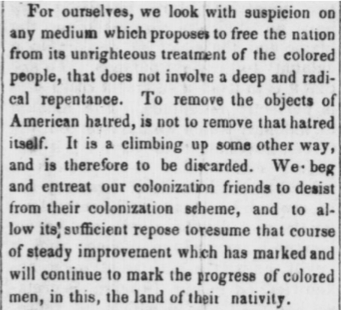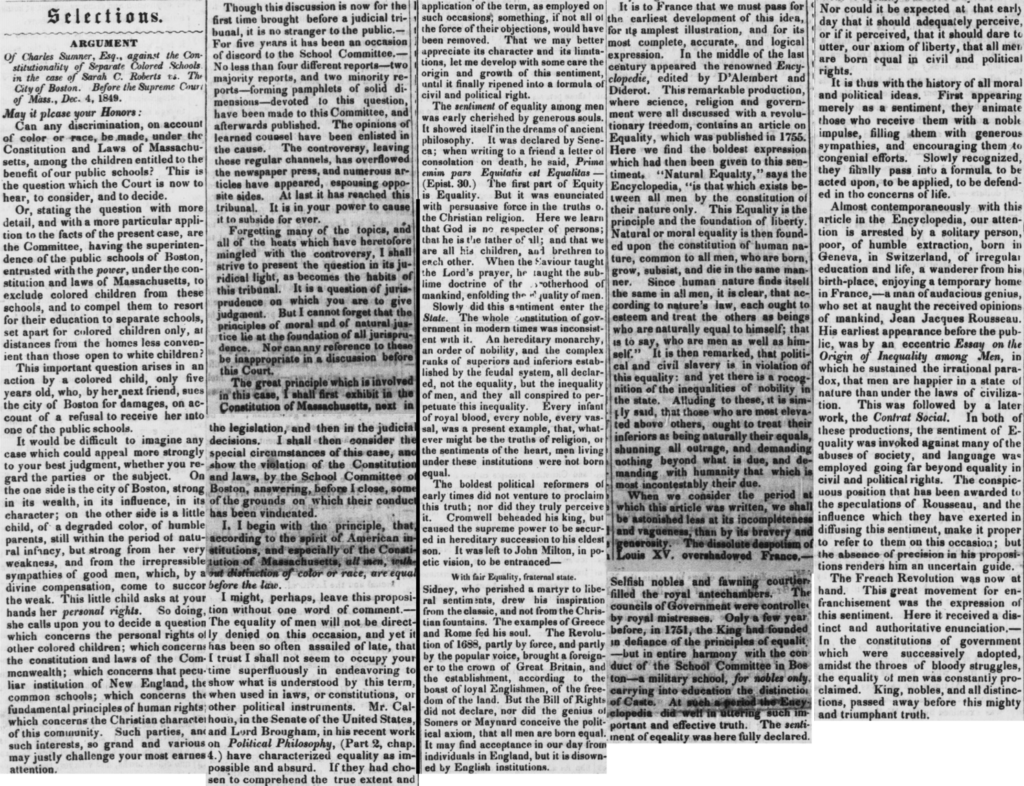
The North Star was not just a way to share opinions, it was also a key voice for demonstrating the organizational power of the abolitionist cause. Throughout the Northeast and Midwest, the newspaper highlighted events and gatherings that spoke to the goals of abolitionism as well as the advancement of Black Americans. Because many enslaved people escaped to Canada rather than risk being recaptured, articles also occasionally appeared from cities in Canada.1 In gathering together, Black Americans sought to critique the way that the country had treated them, generate further support for abolition, and empower themselves as a community.2 This was not exclusive to the South, and Douglass harshly criticized the racism and vitriol that he and other people of color experienced in Northern cities.
Topics and First Articles
Abolitionists in the United States and abroad attempted to organize for the end of slavery and discrimination against people of color. Newspapers highlighted the various organizations that were active in the abolitionist movement, as well as the causes they supported. The first chart below looks at some key abolitionists, their organizations, and means of expressing support for a particular cause (clapping, cheering, etc.) Looking first at the text analysis topics related to the abolitionist community and abolitionist organizations, there are some clear trends around the frequency of The North Star’s coverage. Mouse over individual points on the line to learn more about what date an article was published or see what percentage of that topic made up an issue of the paper:
| Anti-Slavery Community | meeting people committee friends resolved antislavery north received colored called york question president convention public position present star body state |
| Support | cheers applause laughter meeting hall boston american hear thompson sir loud brown england speak colonization audience massachusetts ladies dinner chains |
| British Abolitionism | thompson fugitive british snd lord jenny george bill hia protestant lind disturbance march advertiser marshal toronto africa moves fillmore corinthian |
| Massachusetts Anti-Slavery Society | massachusetts phillips quincy carolina garrison sabbath palfrey wendell parker wright samuel isaac boyd winthrop theodore edmund railroads jackson englishman pillsbury |
| Anti-Slavery Events | fair antislavery father appeal bazaar peace lecture mathew august earnestly ihe hungary barrett kossuth brown july garnet british west celebration |
Compared to some other themes in The North Star, discussions of organizing were consistent over the entirety of the paper’s publication. Discussions of the Anti-Slavery Community were another especially frequent feature. On top of that, petitions and other means of showing support became occasional additions to the paper. These shows of support could come from many places and organizations, but a crucial organization was the Massachusetts Anti-Slavery Society. Amongst abolitionist groups in the United States, they played a very important role. Events held by the Society, and its meetings, were featured heavily in The North Star and the minutes of the organizations key events were reprinted in full on occasion.

The topic analysis draws some distinction between words that are associated with meetings, and those associated with other kinds of events. Anti-Slavery fairs and bazaars were often fundraising events that would raise money for local abolitionist organizations, newspapers, or other causes. Articles like this “Appeal in behalf of the Western New York Anti-Slavery Fair” appeared in the paper to broadcast fundraising events and highlight the continued work that abolition demanded.
The abolitionist community did not speak with a single voice, but instead was made up of many newspapers, groups, and activists who did not always agree on the exact principles of their movement even if they agreed that slavery was horrific. Critiques targeting slavery and those that supported it highlights how abolitionists sought to maintain their movement, and how abolitionists remained active outside the politics of Washington, D.C. or individual states.
| Colonization of Liberia | colonization liberia africa resolution scheme wilson roberts adopted dawn agent colony insult monrovia charges taste buy influences slavetrade morality liberian |
| Equality/Equal-Treatment | equality connecticut colonies mental glass mill auld positive administrators aro eagle secret york homans scotchman consolation pens boats hanchen repress |
| Religious Anti-Slavery | god man slave world great men law life power work good liberty america give death family poor heart christian american |
| Criticism of Churches and Pastors | church thomas protestant drayton bridge mason episcopal hostile toi sacrifice ireland palfrey philadelphia gloucester survey uncompromising gold proslavery orders bazaar |
| Education | school schools children education attendance board teacher provided average separate postage scholars teachers districts primary hath department taught seats electors |
Several abolitionist causes and perspectives remained prominent throughout the paper’s publication. From this chart, it is clear that religious discussions of slavery played a major role in The North Star. Religious discussions focused on how slavery offended Christian morality, but also focused on pastors, churches, and individuals failed to uphold that reality themselves. Similar to individual senators that publicly or quietly supported slavery, pastors and churches that supported slavery or were enslavers themselves were criticized for their failure to adhere to Christian values.

Other niche topics like the colonization of Liberia represented tensions within the abolitionist movement. Some Black abolitionists believed that they should leave the United States and return to Africa. The emigration of Black Americans back to Africa was supported by the American Colonization Society. The colony (Liberia) and its capital Monrovia continue to exist as an independent nation in West Africa. Douglass did not support the American Colonization Society, and The North Star frequently referred to the entire idea as the “colonization scheme”. This excerpt from a longer article on the topic from the June 27, 1850 edition of the paper highlights the view that colonization was not a true solution, as it removed Black Americans from their native land while failing to solve the issues of white supremacy. This opinion may not have been shared by both Frederick Douglass and his co-editor M.R. Delany however. Delany came to support the colonization movement and emigrated to Liberia, before returning to participate in the Civil War.
The first articles in The North Star allow for a deeper understanding of abolitionist perspectives, and further highlights the extent to which the paper emphasized the abolitionist community. The first articles point to major concerns about racism and oppression, but even more highlight religious perspectives in campaigning for abolition. Related to that, the paper and the broader abolitionist community sought to criticize those who used religious convictions to justify their support for slavery. Critiquing people who used their religious positions to support and maintain slavery was not seen just as a religious issue, but one that directly undermined public morality in the United States. While parts of this are clear from looking at the peaks that most heavily relate to “Criticism of Churches and Pastors”, the first articles routinely criticized those who loudly proclaimed their Christianity while arguing for the continuation of slavery.
The newspaper, in its first articles and in other sections, sought to highlight the breadth of the activist community in the United States. Looking at first article locations that specifically emphasized meetings, there are several examples of events that focused on abolitionism or advancing the cause of equality for people of color in the United States. These longer meeting minutes or transcripts from other events were just one of the ways that The North Star informed its readers about abolitionist activities. The second page of the paper often began with a list of upcoming events or meetings throughout the North. The map above highlights the first articles that specifically dealt with abolitionist meetings or events. These articles showcased conventions and meetings through the Northeast and Midwest. Major centers of the abolitionist movement, like Boston and New York, were clearly prominent. Smaller towns and cities in the North also appeared as sites of key events, and highlighted an abolitionist movement that supported equal rights for people of color.
The two example articles below build off of the topics and perspectives that are visible in the analysis above. Both articles highlight elements of antebellum activism, whether the advancement of Black Americans or related fights against discrimination and segregation. Each example includes important context about the article and it subject matter, and end with questions or observations that ask you to think about the relationship between the article and the broader subject matter of the paper.
Example Articles
Advancement of Black Americans
On top of representing the actions and support given to the anti-slavery community, the newspaper sought to empower Black Americans. This meant pushing back against racism and discrimination where it existed, but also pushing for continued economic advancement. This article, written by Douglass, highlighted the mistreatment of Black Americans in cities alongside the economic inequality they experienced.

What opinions is Douglass presenting in relation to the treatment of Black Americans? Do you see any relationship between the ideas expressed in this article and the excerpt from “On the Letter from Benjamin Coates” above that discussed emigration to Liberia? Looking at this article, even though it was not located on the first page, how would you categorize some of the argument that Douglass is making?
Fighting Discrimination and Segregation
Over four issues, the paper ran the arguments of Charles Sumner in the case of Sarah C. Roberts vs the City of Boston. Sarah C. Roberts was a young girl living in Boston, who was forced to attend a segregated elementary school far from her home. The aim of the case was to overturn segregation in the Boston school system, on the grounds that it violated the state constitution and made a mockery of the principle of equality. Though the case failed, it offers an example of how the newspaper confronted discrimination throughout the United States.

| Education | school schools children education attendance board teacher provided average separate postage scholars teachers districts primary hath department taught seats electors |
| Equality/Equal Treatment | equality connecticut colonies mental glass mill auld positive administrators aro eagle secret york homans scotchman consolation pens boats hanchen repress |
Looking closely at the “Education” topic in the table above, you might notice a shared vocabulary with Sumner’s argument. Sumner is not only talking about education however, he’s also situating education within a broader discussion about equality. In the “Equality/Equal Treatment” key words, do you see any shared focus with Sumner’s argument? How would you interpret these words, and how would you categorize Sumner’s argument?
Conclusion
The abolitionist community rooted in papers like The North Star was deeply invested in showing its audience examples of abolitionist support both within the United States and elsewhere. It emphasized the abolition of slavery in the British Empire as an example for the United States to follow, and incorporated the speeches and writings of British abolitionists into its pages. It engaged in fundraaising efforts that helped to sustain indvidiual organizations, as well as newspapers like The North Star.
While slavery represented a clear and present danger for people of color, and a threat to the American political system, it was not the only thing the abolitionist community focussed on. The paper emphasized key issues of inequality that are recognizable today, like equal access to quality education. In looking at how the racial inequality between white Americans and Black Americans was critiqued in the paper, there was a clear focus that expanded beyond a North vs South dichotomy. In these articles the paper emphasized the way both North and South continued to fail people of color, and discussed how the situation could be improved.
Looking at how the abolitionist movement organized itself, what differences do you see with how todays movements are organized? Topics like segregation in the education system continue to be topics in Boston and other major American cities. What does does this say about the progress that has been made since Douglass’ time?
- “Speech of Geo Thompson in Toronto, Canada” The North Star, April 17, 1851, p. 1.
- “An Address to the Colored Men of Connecticut” The North Star, October 19, 1849, p. 1.